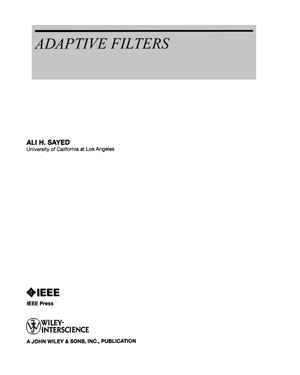Printed in the United States of America.
2008 by John Wiley & Sons, Inc.
ISBN 978-0-470-25388-5.
820 p.
I am indebted to the many readers and colleagues who have written to me on several occasions with encouraging feedback on my earlier textbook Fundamentals ofAdaptive Filtering (Wiley, NJ, 2003). Their enthusiastic comments encouraged me to pursue this second project in an effort to create a revised version for teaching purposes. During this exercise, I decided to remove some advanced material and move select topics to the problems. I also opted to fundamentally restructure the entire text into eleven consecutive parts with each part consisting of a series of focused lectures and ending with bibliographic comments, problems, and computer projects. I believe this restructuring into a sequence of lectures will provide readers and instructors with more flexibility in designing and managing their courses. I also collected most background material on random variables and linear algebra into three chapters at the beginning of the book. Students and readers have found this material of independent interest in its own right. At the same time, I decided to maintain the same general style and features of the earlier publication in terms of presentation and exposition, motivation, problems, computer projects, summary, and bibliographic notes. These features have been well received by our readers.
2008 by John Wiley & Sons, Inc.
ISBN 978-0-470-25388-5.
820 p.
I am indebted to the many readers and colleagues who have written to me on several occasions with encouraging feedback on my earlier textbook Fundamentals ofAdaptive Filtering (Wiley, NJ, 2003). Their enthusiastic comments encouraged me to pursue this second project in an effort to create a revised version for teaching purposes. During this exercise, I decided to remove some advanced material and move select topics to the problems. I also opted to fundamentally restructure the entire text into eleven consecutive parts with each part consisting of a series of focused lectures and ending with bibliographic comments, problems, and computer projects. I believe this restructuring into a sequence of lectures will provide readers and instructors with more flexibility in designing and managing their courses. I also collected most background material on random variables and linear algebra into three chapters at the beginning of the book. Students and readers have found this material of independent interest in its own right. At the same time, I decided to maintain the same general style and features of the earlier publication in terms of presentation and exposition, motivation, problems, computer projects, summary, and bibliographic notes. These features have been well received by our readers.

